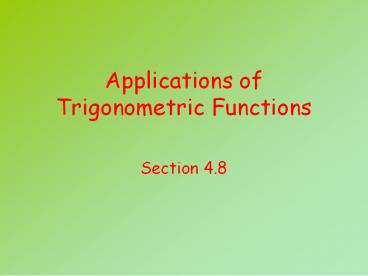Applications of Trigonometric Functions - PowerPoint PPT Presentation
Title:
Applications of Trigonometric Functions
Description:
The object is pulled down 6 centimeters from the rest position and then released. ... by the equation below, where t is measured in seconds and d is in inches. ... – PowerPoint PPT presentation
Number of Views:92
Avg rating:3.0/5.0
Title: Applications of Trigonometric Functions
1
Applications of Trigonometric Functions
- Section 4.8
2
Objectives
- Model simple harmonic motion
- Determine the maximum displacement, frequency,
and period of an object in simple harmonic motion - Apply Law of Sines and Law of Cosine to solve
triangles.
3
Vocabulary
- simple harmonic motion up and down oscillations
(ignoring friction and resistance) - equilibrium position rest position
- maximum displacement - amplitude
- period how long it takes for the motion to go
through one complete cycle - frequency one divided by the period
4
Formulas
- simple harmonic motion
used when the object is at its greatest distance
from rest position at the origin
used when the object is at its rest position at
the origin
5
An object is attached to a coiled spring. The
object is pulled down 6 centimeters from the rest
position and then released. The period of the
motion is 4 seconds. Write an equation for the
distance of the object from its rest position t
seconds.
6
An object is attached to a coiled spring. The
object is initially at rest position and then
pulled down 5 centimeters from the rest position
and then released. The period of the motion is
1.5 seconds. Write an equation for the distance
of the object from its rest position t seconds.
7
An object in simple harmonic motion is described
by the equation below, where t is measured in
seconds and d is in inches.
- Find each of the following
- The maximum displacement
- The frequency
- The time required for one cycle
8
- Solve the triangle
C
a 10
b 12
A
B
c 16
9
Determine if the following measurements produce
one triangle, two triangles, or no triangles.
a 10, b 40, A 60?
10
Determine if the following measurements produce
one triangle, two triangles, or no triangles.
a 42.1, b 37, A 112?
11
Determine if the following measurements produce
one triangle, two triangles, or no triangles.
a 20, b 15, A 40?































